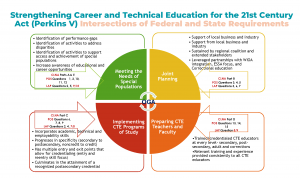 Since the fall of 2021, Advance CTE’s Opportunity Gap Analysis (OGA) workshop has provided training, resources, and support to help state leaders identify and address gaps in access to high-quality Career Technical Education (CTE). To date, Advance CTE has led in-depth gap analysis training with 39 state teams from across the country. These teams have further disseminated the gap analysis process within their state CTE systems, resulting in changes in policies and practices that bring identifying and addressing gaps to the forefront of their CTE programs. This is the third post in a blog series where Senior Policy Associate, Jessi Maddox, interviews previous participants of the OGA workshop to share the impact and the lessons learned from implementing the training in their state.
Since the fall of 2021, Advance CTE’s Opportunity Gap Analysis (OGA) workshop has provided training, resources, and support to help state leaders identify and address gaps in access to high-quality Career Technical Education (CTE). To date, Advance CTE has led in-depth gap analysis training with 39 state teams from across the country. These teams have further disseminated the gap analysis process within their state CTE systems, resulting in changes in policies and practices that bring identifying and addressing gaps to the forefront of their CTE programs. This is the third post in a blog series where Senior Policy Associate, Jessi Maddox, interviews previous participants of the OGA workshop to share the impact and the lessons learned from implementing the training in their state.
As we approach the end of 2024, the current cohort of OGA workshop state teams from Connecticut, New Hampshire, New Jersey, New York, North Carolina, and Pennsylvania are coming to the end of their six months of collaborative peer learning opportunities. As Advance CTE closes out this latest cohort, we wanted to continue to connect with prior participants and ask about the impact the gap analysis training has had on equal access to CTE programs within their state. This month we are spotlighting the Career, Standards and Assessment Services Team with the Kansas State Department of Education (KSDE) and the Workforce Development Unit with the Kansas Board of Regents, and the work their combined team has done since the culmination of their cohort in Winter 2023.
When did your state participate in the Opportunity Gap Analysis Workshop, and what in-state training(s) has your team facilitated using the workshop model and/or related resources?
Kansas participated in the initial Opportunity Gap Analysis Workshop in June of 2023 with a team that consisted of the Director of Workforce Development, the Secondary and Postsecondary Associate Directors of CTE, and other assistant directors and programs consultants from each level. This cross-sector team participated in the subsequent Communities of Practice learning space offered by Advance CTE through December 2023.
Several training opportunities were held throughout the state following our participation in this opportunity. At the secondary level, the Kansas State Department of Education provided an overview of OGA during our annual Secondary Improvement Application training. We also incorporated Advance CTE resources within the Comprehensive Local Needs Application (CLNA) to help Local Education Agencies (LEAs) create action plans and strategies for any identified gaps in enrollment and performance.
At the postsecondary level, the Kansas Board of Regents held a gap analysis workshop with representatives from each Perkins V funding recipient on August 1, 2024. Especially well received were the root cause and strategies materials provided. We now also include OGA in many faculty and staff trainings at postsecondary institutions.
Describe how your team’s participation in the Opportunity Gap Analysis training impacted CTE in general within your state:
At the secondary CTE level, the Opportunity Gap Analysis training helped create renewed focus on resource allocations for gap areas. This included application changes for secondary program Improvement grants. Clearer expectations and Advance CTE resources resulted in improved action plans and budgets to support strategies for gaps. A reserve grant to increase equitable access to CTE was also offered.
At the postsecondary level, focusing on analyzing gaps opens the opportunity for conversations that are not happening on campuses. With the help of OGA methodology and materials, CTE issues are put into context and issues can be seen instead of hidden. The grouping of root causes into themes was very helpful to the sub-recipient to see that programs may experience similar challenges regardless of content.
Describe how the Opportunity Gap Analysis training specifically led to changes in your state’s data policies and procedures:
No state policy or procedure changes have been made to date, but the two state offices are asking for different kinds of reports now, and we also make sure that all institutions collect data from all students so that CTE student data is not evaluated in a vacuum.
Please describe any steps that have been taken to improve access for CTE learners after going through the CTE opportunity gap analysis process:
At the secondary level, a Perkins reserve grant was offered in the spring of 2024 to increase equitable access to CTE. Grant recipients were asked to form a team to include a middle school principal, middle school counselor, middle school special education staff, high school principal, high school CTE coordinator, high school counselor, and high school special education staff.
| Secondary local-level grant teams were asked to:
1) Introduce all students, families and educators to career clusters and pathways. 2) Collaborate with KSDE specialists in the special population areas that align with the special populations served in the district. 3) Collaboration of CTE and special education staff to increase special population enrollment in CTE courses. |
Grant teams are diligently working to expand equitable access in their LEAs, and will be building upon the OGA process to realize those goals going into 2025.
2024-2025 monthly CTE & Perkins webinars will incorporate guest speakers to review and provide strategies for core indicators and special population groups.
Postsecondary – OGA methodology is now included in the CLNA, with grant recipients updating the performance gap analysis section on their local applications each fiscal year. The state incorporated OGA as the model for the analysis section due to the system’s in-depth and cyclical nature.
Next Steps
If your organization is interested in learning more about what it takes to conduct a gap analysis in your state, or other opportunities to engage with Advance CTE’s suite of resources addressing methods to close access gaps, fill out the Technical Assistance Interest Form for personalized options that can help both staff and learners succeed.
 The next cohort of the Opportunity Gap Analysis workshops will launch in the Spring of 2025. In this six-month cohort Advance CTE is providing training, resources and support to help state leaders identify and address gaps in access to high-quality work-based learning programs. Keep an eye out for upcoming information sessions and the cohort application on the Opportunity Gap Analysis page of the Advance CTE website.
The next cohort of the Opportunity Gap Analysis workshops will launch in the Spring of 2025. In this six-month cohort Advance CTE is providing training, resources and support to help state leaders identify and address gaps in access to high-quality work-based learning programs. Keep an eye out for upcoming information sessions and the cohort application on the Opportunity Gap Analysis page of the Advance CTE website.




 In recent years, middle school career exploration has gained traction as a foundational element of Career Technical Education (CTE). As many State CTE Directors and leaders know, the
In recent years, middle school career exploration has gained traction as a foundational element of Career Technical Education (CTE). As many State CTE Directors and leaders know, the  After over three weeks without a leader, the House elected a new Speaker on Wednesday — Rep. Mike Johnson (R-LA). Over the last several weeks a slew of earlier candidates failed to garner the necessary support for this role, including Majority Leader Steve Scalise (R-LA), Judiciary Committee Chairman Jim Jordan (R-OH), and most recently, Majority Whip Tom Emmer (R-MN). Following these failed candidacies, House Republicans reconvened late Tuesday night this week to conduct another informal straw poll to determine a new candidate for the Speakership. After winnowing a field of eight declared candidates, Johnson ultimately prevailed over Rep. Byron Donalds (R-FL) by a margin of 128-29. The next day, acting Speaker Patrick McHenry (R-NC) reconvened the chamber to vote for a new Speaker where Johnson prevailed over current Minority Leader Hakeem Jeffries (D-NY) by a margin of 220-209.
After over three weeks without a leader, the House elected a new Speaker on Wednesday — Rep. Mike Johnson (R-LA). Over the last several weeks a slew of earlier candidates failed to garner the necessary support for this role, including Majority Leader Steve Scalise (R-LA), Judiciary Committee Chairman Jim Jordan (R-OH), and most recently, Majority Whip Tom Emmer (R-MN). Following these failed candidacies, House Republicans reconvened late Tuesday night this week to conduct another informal straw poll to determine a new candidate for the Speakership. After winnowing a field of eight declared candidates, Johnson ultimately prevailed over Rep. Byron Donalds (R-FL) by a margin of 128-29. The next day, acting Speaker Patrick McHenry (R-NC) reconvened the chamber to vote for a new Speaker where Johnson prevailed over current Minority Leader Hakeem Jeffries (D-NY) by a margin of 220-209. Tell me more about your journey to the Fellowship.
Tell me more about your journey to the Fellowship. Tell me more about your journey to the Fellowship.
Tell me more about your journey to the Fellowship. Dr. Crystal Gardner currently serves as the Instructional Supervisor for the Houston Community College (HCC) Alternative Teacher Certification Program (ATCP). In this role, she oversees instructional operations, program development, quality control, and compliance management. Joining the Fellowship was an exciting opportunity to fully immerse herself in the world of career and technical education (CTE) through equity-aligned learning and real-world practicum.
Dr. Crystal Gardner currently serves as the Instructional Supervisor for the Houston Community College (HCC) Alternative Teacher Certification Program (ATCP). In this role, she oversees instructional operations, program development, quality control, and compliance management. Joining the Fellowship was an exciting opportunity to fully immerse herself in the world of career and technical education (CTE) through equity-aligned learning and real-world practicum.

 This post interviews Community College of Vermont’s Director of Prior Learning Assessment, Melissa DeBlois for insights on the need for this resource and how communicating CPL is realized at the institution and learner level.
This post interviews Community College of Vermont’s Director of Prior Learning Assessment, Melissa DeBlois for insights on the need for this resource and how communicating CPL is realized at the institution and learner level.